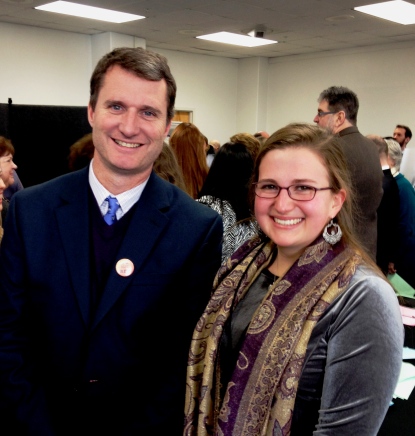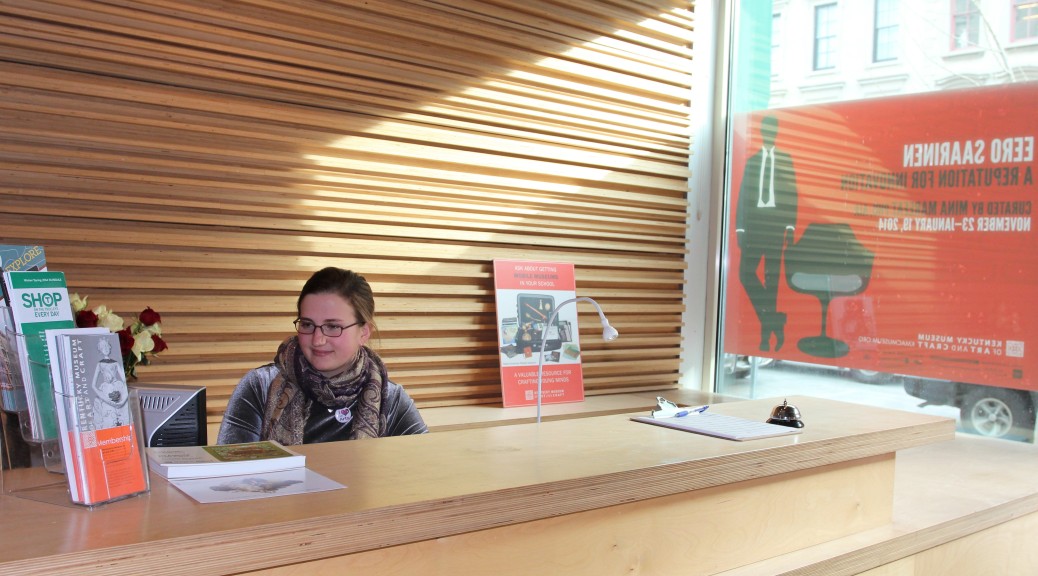My name is Hannah Ensign-George and for the month of January I have been interning at the museum with Director Aldy Milliken. As a junior art history and religion double major at Centre College in Danville, having an opportunity to work at KMAC has been wonderful. Because of KMAC’s smaller size my internship has encapsulated multiple facets of museum life from being the public face of the museum down at the front desk to solving the puzzle of packing the materials from the Eero Saarinen show for shipment.
Putting My Best Face Forward- sitting at the front desk is an opportunity to interact with the public and get a sense for why people visit the museum. Some visit because they were walking past and the exhibit caught their eye. Others have been planning to come to the exhibit since hearing about it. Another duty of the desk is to answer the telephone, which is always interesting. Telephone calls are another form of interaction just as important as greeting someone when they come in the front door. I found the first few calls to be nerve-wracking, but once I figured out a system that worked for me, they were a breeze. Still that didn’t stop me from nearly jumping out of my skin when the phone rang; it rings really loudly.
Valuable Research- when preparing for a new exhibit: research begins months in advance and doesn’t end until the exhibit is over. Each piece a curator plans to show has to have extensive background information to explain how it fits into the central idea or theme. Sometimes connections between pieces don’t become clear until more is known about their history and their creators. When I was researching for an upcoming show, Press, I found a wealth of information about the printing industry here in Kentucky. There is a remarkable printing press community in this state, from Larkspur Press in Monterey, Kentucky to King’s Library Press at the University of Kentucky. Connections can then be made from these press businesses to William Morris’ Baskerville Press in late 19th responsible for initiating the private press movement. Without research these types of connections wouldn’t be made.
It Pays to Get Out- museums depend on generous grants from a variety of government organizations including the National Endowment for the Arts. In order to keep museums funded elected officials must be kept aware of issues regarded the arts. This is done by bringing them into the museum and developing strong relationships. Part of my work was contacting state senators and representatives in preparation for 2014 Arts Day in Kentucky. Arts Day in KY is organized by the Kentucky Arts Council to bring together people with their political leaders. Awareness days like this help to foster a community between the elected officials and the organizations whose interests they work to promote. On the national level museums must strongly advocate for their importance with members of Congress, to ensure funding continues, but also to help promote museums as a vitally important industry.

Pack it Up, Ship it Out- one of the most exciting times in my internship was packing a closed exhibit for shipment. It was also the most exhausting part because of the manual labor and planning involved, but handling art that you have only looked at is an exhilarating experience. After the pieces have been taken down they have to be carefully wrapped in tissue and bubble wrap. Bubble wrap is the unsung hero of the wrapping process. Then the tricky part arrives: arranging the carefully packaged pieces into their crates. This part becomes an intense Tetris game, with very expensive and fragile blocks. All of the difficulty is forgotten when you look at a well packed crate and know that you solved the puzzle; those pieces are not moving an inch. Though the best part is probably when the crates have been picked up and sent on their way to the next museum, and everyone revels in the calm before setting up the next show.
I came to KMAC in an effort to determine if I wanted to pursue museum work as a career. As annoying as the “What are you going to do after college?” questions are, they remind me to think about myself and what I want to do next. After four weeks at the Kentucky Museum of Art and Craft, this seems like a possibility. Museums combine scholarly research with outreach and working with people.And it doesn’t hurt that I get to spend all day surrounded by art; that is definitely awesome!
Read Hannah’s spotlight feature of being an intern on Centre’s Blog.









